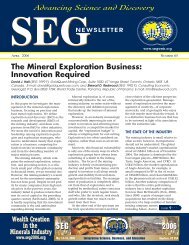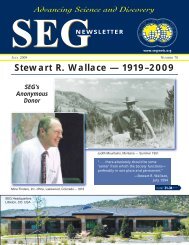SEG 45 Final_qx4 - Society of Economic Geologists
SEG 45 Final_qx4 - Society of Economic Geologists
SEG 45 Final_qx4 - Society of Economic Geologists
You also want an ePaper? Increase the reach of your titles
YUMPU automatically turns print PDFs into web optimized ePapers that Google loves.
OCTOBER 2005 • No 63 <strong>SEG</strong> NEWSLETTER 13<br />
2000<br />
1600<br />
1200<br />
800<br />
400<br />
0<br />
500<br />
400<br />
300<br />
200<br />
100<br />
0<br />
6000<br />
4000<br />
2000<br />
As Enzyme Leach, ppb<br />
Se Enzyme Leach, ppb<br />
Na Deionized Water Leach, ppm<br />
0<br />
473500 474000 47<strong>45</strong>00 475000 475500 476000<br />
Spence<br />
Deposit<br />
elements be moved from depth to the<br />
surface, either in gaseous form or dissolved<br />
in water. In arid regions, advective<br />
transfer, as by barometric pumping<br />
<strong>of</strong> air containing gas through fractured<br />
rock or seismic pumping <strong>of</strong> mineralized<br />
groundwater through fractured rock,<br />
appears to be more effective than diffusive<br />
processes (Cameron et al., 2004).<br />
The diffusion <strong>of</strong> gas through air and<br />
rock is slower than advection, and diffusion<br />
<strong>of</strong> dissolved constituents in the<br />
water film that exists around grains in<br />
the vadose zone is ineffective because<br />
the rate that these films migrate downward<br />
is orders <strong>of</strong> magnitude faster than<br />
the upward rates <strong>of</strong> diffusion.<br />
Exploration methods based on diffusion<br />
(e.g., Hamilton, 1998; Smee, 2003) may<br />
have greater application in regions like<br />
the Canadian Shield, where recent<br />
seismicity is rare, where the climate is<br />
wetter, and where sediments <strong>of</strong> glacial<br />
Eastern Fracture<br />
Zone<br />
120000<br />
80000<br />
40000<br />
15000<br />
10000<br />
5000<br />
origin that are generally unfractured<br />
cover mineralized basement rocks.<br />
In this article we have described two<br />
examples from seismically active,<br />
hyper-arid and semi-arid regions <strong>of</strong><br />
advective transfer <strong>of</strong> elements by<br />
pumping <strong>of</strong> mineralized groundwater<br />
along faults. Surface flooding <strong>of</strong> a<br />
desert area, as envisaged at Spence,<br />
appears counterintuitive. Nevertheless,<br />
flooding after earthquakes has been<br />
widely reported. Sibson (1981)<br />
described changes in well water level,<br />
spring flow, and occasional dramatic<br />
effusions <strong>of</strong> groundwater immediately<br />
following moderate to large shallow<br />
earthquakes. Surface flows have been<br />
documented in Iran during earthquakes<br />
in 1903 and 1923 (Tchalenko,<br />
1973). Following the Hebgen Lake<br />
earthquake <strong>of</strong> Montana in 1959, three<br />
rivers increased in flow by ~50%, the<br />
increases continuing for several weeks<br />
0<br />
0<br />
0<br />
500<br />
400<br />
300<br />
200<br />
100<br />
Cu Aqua Regia, ppb<br />
Cu MMI, ppb<br />
Cu Enzyme Leach, ppb<br />
473500 474000 47<strong>45</strong>00 475000 475500 476000<br />
Spence<br />
Deposit<br />
Eastern Fracture<br />
Zone<br />
FIGURE 6. Analytical results for soils from an east-west traverse across the Spence deposit (for location see Fig. 5). Sodium concentrations<br />
were measured by deionized water leach, Se and As by Enzyme Leach, and Cu by Enzyme leach, MMI, and aqua regia. There are fracture<br />
zones in the gravels directly above the deposit and at 476000 m E. Eastings in meters.<br />
through dry weather (Muir-Wood,<br />
1994). After the Kern County,<br />
California, magnitude 7.5 earthquake<br />
<strong>of</strong> 1952 there were outpourings <strong>of</strong><br />
groundwater in the vicinity <strong>of</strong> faults,<br />
and increases in spring flow and well<br />
water level (Briggs and Troxell, 1955).<br />
Thus, the influence <strong>of</strong> structures related<br />
to the emplacement <strong>of</strong> an ore deposit<br />
does not necessarily cease after its primary<br />
formation. As Woodall (2005)<br />
implies, pathways for fluid and energy,<br />
which tend to move toward the surface,<br />
provide an opportunity to recognize<br />
deposits hidden below.<br />
Selective leach techniques have been<br />
widely applied in the search for buried<br />
deposits using soil geochemistry. These<br />
methods attempt to extract the most<br />
mobile fractions <strong>of</strong> the elements that<br />
are present in soils as<br />
water-soluble salts, or<br />
to page<br />
weakly adsorbed on soil 14 ...






